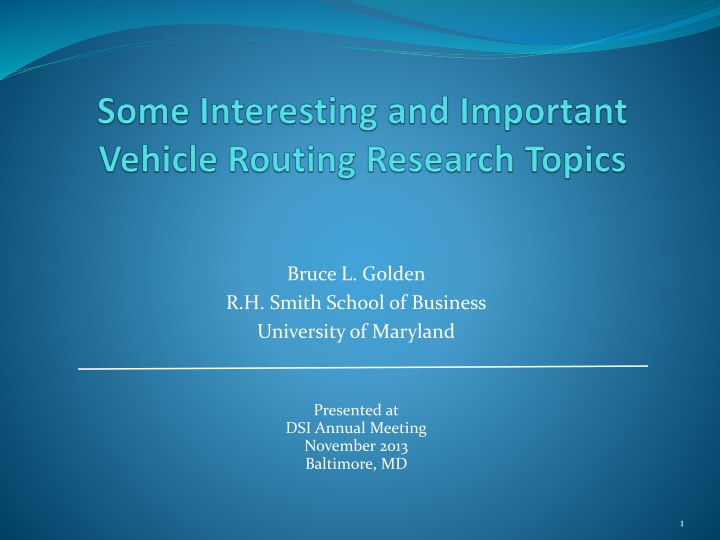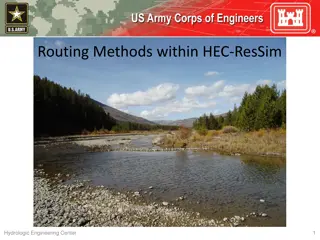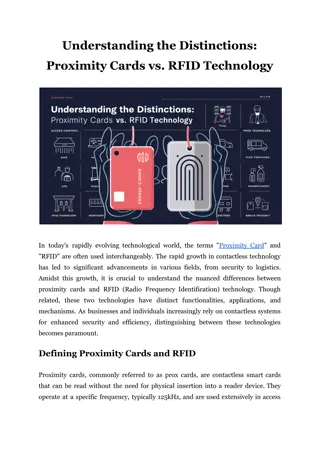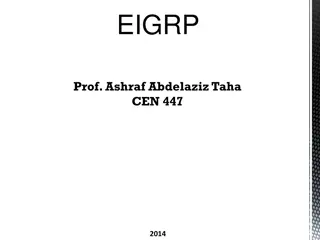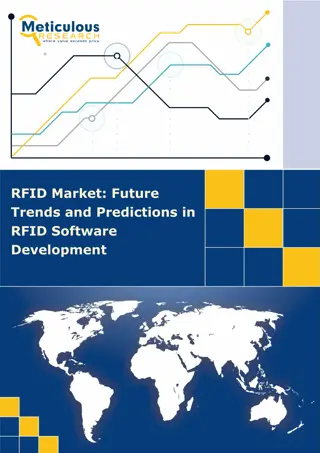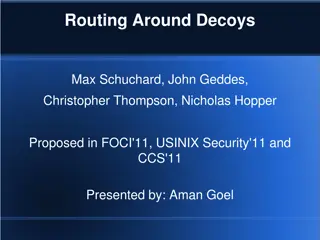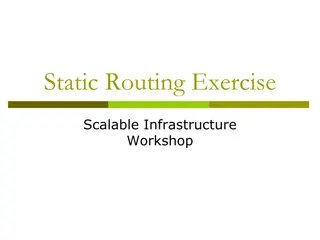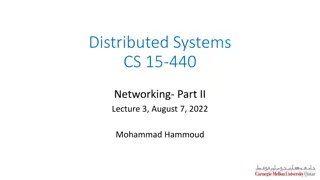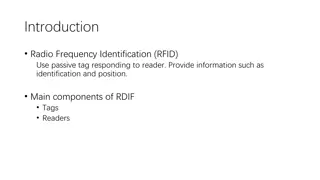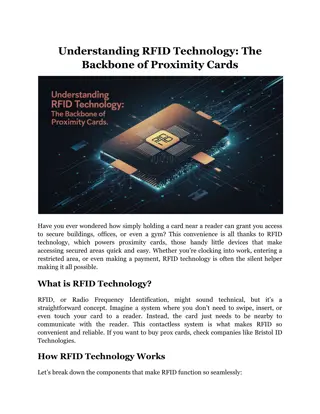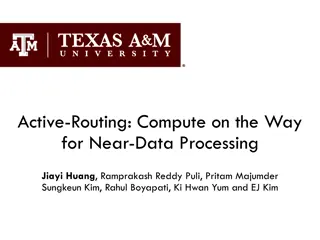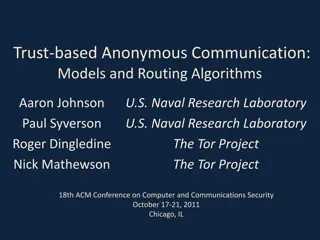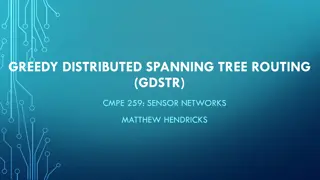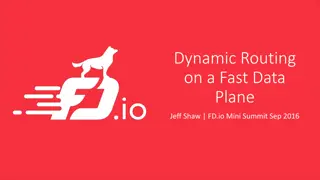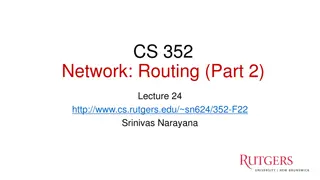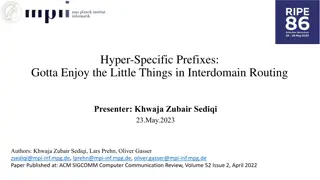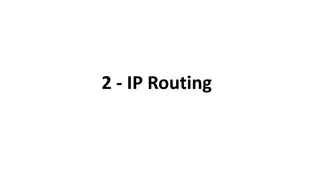Optimizing Vehicle Routing with RFID Technology
Vehicle routing problems, specifically the CETSP over a street network, have evolved with RFID technology. This study explores the implementation of RouteSmart and heuristic approaches to minimize travel distance and time. Results show significant improvements in efficiency with potential future enhancements.
Download Presentation

Please find below an Image/Link to download the presentation.
The content on the website is provided AS IS for your information and personal use only. It may not be sold, licensed, or shared on other websites without obtaining consent from the author.If you encounter any issues during the download, it is possible that the publisher has removed the file from their server.
You are allowed to download the files provided on this website for personal or commercial use, subject to the condition that they are used lawfully. All files are the property of their respective owners.
The content on the website is provided AS IS for your information and personal use only. It may not be sold, licensed, or shared on other websites without obtaining consent from the author.
E N D
Presentation Transcript
Bruce L. Golden R.H. Smith School of Business University of Maryland Presented at DSI Annual Meeting November 2013 Baltimore, MD 1
Outline of Talk Some opening remarks The CETSP over a street network Arc routing with meanderable streets Vehicle routing with customer preference for visit order Additional topics of interest Conclusions 2
Opening Remarks I have worked on vehicle routing problems since 1974 As a researcher As an owner of RouteSmart from 1980 to 1998 Remarkable advances since 1974 This represents a major success story for OR 3
The CETSP over a Street Network Until recently, utility meter readers had to visit each customer location and read the meter at that site Now, radio frequency identification (RFID) technology allows the meter reader to get close to each customer and remotely read the meter In previous work (Shuttleworth et al., 2008), our models were based on data from a utility and used an actual road network with a central depot and a fixed radius r for the hand-held device Our goal was to minimize distance traveled or elapsed time 4
The CETSP over a Street Network We used RouteSmart (RS) with ArcGIS Real-world data and constraints Address matching Side-of-street level routing Solved as an arc routing problem Our heuristic selected segments to exploit the close enough feature of RFID RS routed the meter reader over the chosen segments to obtain a cycle RS solved the problem as a CPP or a RPP 5
Heuristic Implementation How did we chose the street segments to feed into RS? We tested several heuristic ideas Greedy Approaches IP Formulations The focus was on exploiting the power of RFID in order to find a shorter route 6
Shuttleworth et al. Results We presented several heuristics for solving this new class of problems The best heuristics seemed to work well RFID travel paths had a 15% time savings and 20% distance savings over the RS solution As the technology improves (i.e., the radius increases) the savings will continue to increase 7
An Example from RouteSmart Shortly after our work on this topic, RS developed its own commercial capability An illustration is provided on the next few slides So far, the focus has been on improving one route at a time, but partitioning a region into routes is also important 8
RFID Impact on Route Miles 90.0 80.0 - 21% 87.3 70.0 60.0 - 46% 69.2 - 51% 50.0 - 56% 40.0 46.8 43.2 30.0 38.5 20.0 10.0 0.0 Existing Travel Path Method 250' Read Range Buffer 528' (.1 mile) Read Range Buffer 750' Read Range Buffer 1,000' Read Range Buffer 12
RFID Impact on Route Time 6:00 - 19% 5:39 4:48 4:34 - 45% 3:36 - 51% - 56% 3:06 2:24 2:47 2:29 1:12 0:00 Existing Travel Path Method 250' Read Range Buffer 528' (.1 mile) Read Range Buffer 750' Read Range Buffer 1,000' Read Range Buffer 13
Designing Partitions Partitions with r=100 Partitions with r=150 14
Arc Routing with the Meander Option Suppose there is demand for service at homes on a street If the street is narrow and the traffic is light, it is possible (and often desirable) to service both sides of the street in a single pass (i.e., meander in one direction) If the street is wide and traffic is heavy, we must service each side on a different pass (i.e., meandering is not allowed) 15
Meanderable Streets In intermediate cases, we can ask the algorithm to decide which option is best these streets are called meanderable This is an important real-world issue Home delivery of newspapers Trash collection Local delivery (e.g., UPS & Fedex) Meter reading (for now) Maybe USPS delivery Irnich (2005, 2008, 2008) has studied this problem and transformed it to an asymmetric traveling salesman problem, but, otherwise, it has attracted little attention 16
Mixed Windy RPP with the Meander Option Consider a street connecting a and b Streets on which there is no demand are not required For streets where there is demand on only one side, a single pass over a directed arc is required 17
Mixed Windy RPP with the Meander Option For streets where there is demand on both sides, there are three possibilities If Meander = No, we have two directed arcs between a and b If Meander = Yes, we have one undirected edge between a and b If Meander = Maybe, we have one of the above two scenarios 18
Solving the Problem Using IP Zhang & Ming (2013) formulated this problem as an IP It differs from Irnich s IP, but takes about the same amount of time to solve small instances Real-world instances were provided by RouteSmart Zhang & Ming solved an instance with 684 nodes, 4938 arcs, 20 components, and 240 meanderable streets in 145 seconds using CPLEX 12.5 19
Sensitivity Studies In general, we expect Mij + Tij > Max {Sij + Tij, Sji + Tji} and Mij + Tij < (Sij + Tij) + ( Sji + Tji) Zhang & Ming studied the impact of the number and costs of meanderable streets As the number of meanderable streets increases, total cost tends to decrease As the meander cost to service cost ratio increases, we meander less 20
The Importance of Meandering We observe that even when the ratio R is large, it still might make sense to meander Mij + Tij (Sij + Tij) + (Sji + Tji) R= On a real-world instance that we solved, we found one meander with R = 1.2112 and another with R = 1.3523 So, the meander cost can be relatively high and yet still offer cost saving opportunities 21
Future Work There is much work to be done on both exact and heuristic approaches A commercial sanitation client asked whether we can design algorithms that take time of day into account It may be desirable to meander some streets in the early morning (4 to 5 am), but not later 22
Vehicle Routing with Customer Preference for Visit Order Service companies visit customer s homes for inspections, installations, repairs, etc. E.g., cable TV companies A customer is informed that he will be visited on Tuesday, between 9 am and 5 pm For some customers, that is fine Other customers might be willing to pay an extra amount to be visited early or late in the day 23
Customer Preference for Visit Order Given that it may be impossible to estimate the duration of a service call with precision, it makes more sense to ask customers to pay extra to be visited first, second, last, next to last, etc. on a route Two approaches Set a price in advance (e.g., $25, $15, and $5) for first, second, and third on a route Allow customers to bid (or not) for visit order The goal is to minimize {travel cost revenue} 24
Initial Progress on this Problem Sahin, Golden, Raghavan (2013) have begun to study this problem We start with a TSP version One service technician can visit n customers per day We considered two MILP formulations 25
MILP Formulation A modified Dantzig (1963) formulation It has on the order of n3 binary variables 1 if the technician travels from i to j xijt = and visits j in order t 0 otherwise It is rarely used to solve the TSP A modified Miller-Tucker-Zemlin (1960) formulation It has on the order of n2 binary variables 26
Numerical Study 10 instances of 20 customers (n=20) each Coordinates generated randomly in a 100 x 100 square Distances are Euclidean 20%, 30%, or 40% of the customers place bids They bid for the first and last 3 or 5 positions Bids are generated using a Normal distribution The two formulations are solved using CPLEX 12.5 27
Formulation Comparison Bids 20% 30% 40% Formulation B & B Nodes CPU Time (s) Average LP-IP Gap Dantzig 2624 6.9 13.02% MTZ 371,279 82.3 46.51% Dantzig 545 2.8 12.62% MTZ Dantzig 2449 6.7 9.91% MTZ 1,105,837 225.1 58.48% 9,871,894 2401.4 63.44% The MTZ formulation seems sensitive to the percentage of customers bidding The Dantzig formulation shows no such sensitivity 28
Future Work We have managed to solve (to optimality) instances with 50 customers for the TSP version and 80 customers for a VRP version (both with bidding) The VRP version assumes there are K vehicles and that each vehicle services exactly Q customers (i.e., KQ = n) There is much work to be done on both exact and heuristic approaches 29
Conclusions We have witnessed enormous progress in vehicle routing over the past 40 years We can all take pride in the many successful implementations of vehicle routing software Still, there is so much more work for us to do 30
